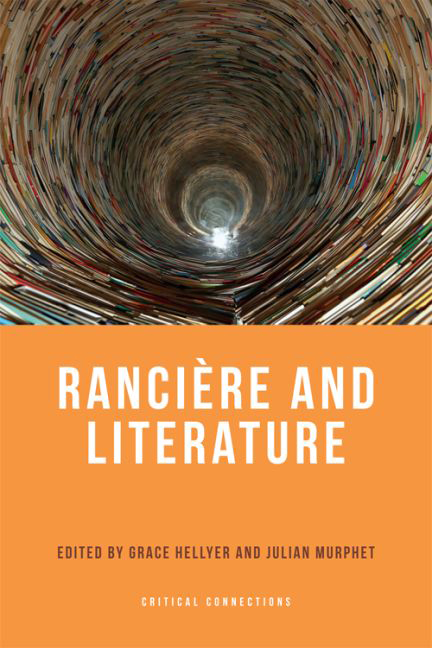Book contents
- Frontmatter
- Contents
- Acknowledgements
- Notes on Contributors
- Introduction: Rancière and Literature
- SECTION I Coordinates
- 1 Fictions of Time
- 2 Jacques Rancière in the Forest of Signs: Indiscipline, Figurality and Translation
- 3 Rancière and Tragedy
- 4 Rancière Lost: On John Milton and Aesthetics
- 5 ‘A New Mode of the Existence of Truth’: Rancière and the Beginnings of Modernity 1780–1830
- SECTION II Realisms
- SECTION III Contemporaneities
- Index
2 - Jacques Rancière in the Forest of Signs: Indiscipline, Figurality and Translation
from SECTION I - Coordinates
Published online by Cambridge University Press: 15 September 2017
- Frontmatter
- Contents
- Acknowledgements
- Notes on Contributors
- Introduction: Rancière and Literature
- SECTION I Coordinates
- 1 Fictions of Time
- 2 Jacques Rancière in the Forest of Signs: Indiscipline, Figurality and Translation
- 3 Rancière and Tragedy
- 4 Rancière Lost: On John Milton and Aesthetics
- 5 ‘A New Mode of the Existence of Truth’: Rancière and the Beginnings of Modernity 1780–1830
- SECTION II Realisms
- SECTION III Contemporaneities
- Index
Summary
‘I must verify the reason for my thought, the humanity of my feelings, but I can do it only by making them venture forth into the forest of signs that by themselves don't want to say anything, don't correspond with that thought or that feeling.’ What kind of adventure is this? Why must we verify our very humanity? Moreover, why should such verification be carried out in the middle of the obviously obscure forest of signs? In order to answer these questions, we first need to think about how we conduct our reflections, the means we can use, and the relations we are able to create.
Indisciplining
Let us begin with a question of method: though he studied and taught philosophy and conducted historical research on nineteenth- century workers’ archives, Jacques Rancière is first of all a reader. As we all are. But he is a much more patient and attentive reader than most, and one who resists falling into disciplinary habits. Maybe he learned from the nineteenth-century workers he studied for years that one does not always need to walk on well-paved roads. He wrote a remarkable historical study about them, without being a historian or ‘applying’ a historical method. When he wrote about the methods of ‘true’ historians, it was less to criticise them or to propose other ways of interpreting archives than to reveal how they constituted, without acknowledging it, a poetics of knowledge. It was not a way of undermining their force or of assigning them the status of fiction (as has sometimes been done by philosophers or literary critics). It was a way to make visible the distribution of territories at work in specific historical research. Indeed, fiction should not be understood as the invention of pure imaginary worlds; it is what Jacques Rancière calls a ‘structure of rationality’ – that is, a way of presenting and associating things, situations or events in order to make them perceptible and intelligible.
- Type
- Chapter
- Information
- Rancière and Literature , pp. 42 - 57Publisher: Edinburgh University PressPrint publication year: 2016

